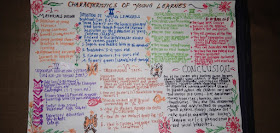Name : Afin
Puapita R
NIM : 2109180033
Class : 2C
English for
Young Learner
Young learner i a
cacth-all for student who are not yet adults. And here are more about young
learner.
Characteristics
of young learner in learning language :
1.
Individual Attention
It is really Important for taecher to give an individual attention for
young learner. By talking with them or asking them about some vocabulary. It
can be done in some activities suc as class journal, pre-activity, or some
small circle.
2.
Attention Span
Children are very difficult to keep their attention for to long . And the
durations are different accrding to their ages. The duration for young learner
are about 15 to 30 minutes. So the teacher have to work as hard as possible so
that children keep their attentions to the teacher.
Ways to teach
language for young learner :
1. Listening and
speaking language are more prioritized than reading and writing.
2. When teaching the new
concept, make sure to relate it to what they already know in their own language.
3. Use English as much
as possible.
4. Teacher’s main goal
is to make sure the student undestand the language they are being taught.
5. Allow the children to
use their first language, then give the English version of what thei said.
6. When they understand,
then the next aim is to make them can produce the language.
7. Star with simple
vocabularies.
8. Learn and memorize it
slowly with much reapetitions.
9. The next step is to move to sentences, and
make sure the children understand the language.
10. Make some good
routines.
11. Use body language
12. Use games, involve
the children in it, and make it fun.
13. Use song to increase
children’s abilities in vocabulary and grammar of language even without trying.
Class Management
and Atmosphere
1.
Ideal Teacher
Every student have their favorite teacher. Such as teacher who has a
beautiful smile, or teacher who lively , or techer who is really patient. Those are personalities that not everyone can
have. But it does’t mean techer who does’n have those personalities can’t be a
good teacher. They can improve in their abilities and attitude.
a.
Abbilities: Even if you are not an expert but at
least you can sing or play music to make your class more enjoyeble.
b.
Attitude: You sould be fair to all of the student
and not prioritize one above another.
2.
Helping the children to feel secure
Make the children to feel secure and confortable in the class.
a.
Make them feel secure when they know that you ere
in charge in their class.
b.
Repect the
students
c.
Let them make a mistake, don’t correct them as
long as it is not in language exercises, and tell them not to be affraid of
doing something wrong because everyone can make a mistake.
d.
Having some good routines.
e.
Give them some responsibility for doing practical
job in classroom.
f.
Don’t make an organized competition.
g.
Avoiding for giving a physical prize.
h.
Don’t give childrens english name.
3. The Physical
Children will respond well when they are familar with their surrounding.
The teacher can make some English Corner if the place are not that wide, they
can put some shelf to put books, or things that can be used in learning
language, and children can participate to decorate it by puting what they like
or what they bring from home such us small plant, post card, or some colorful
pins. Make the corner beautiful, and comfortable for children to play there.
4.
Arranging the desk
a. In
arrangement A, the teachers can arrange the desk by four desks per group that
make it’s easy for a group work, and
leaving the space in the middle than can help the teachers to reach every
students.
b. For arrangement B, the students sit sepatarely
and they can only see the back of one who sit in front of them, so it is not
suitable in language class.
c. The
last arrangement is similar to arrangement B but a bit more flexible and there
are more space for teachers to move
5.
Grouping the children
The teachers can group the YL in pair or with
group as needed.
a. Pairwork can be made by pairing with their
deskmate. It can be made as a routine.
b. Groupwork can be made for activities that need
more people, when the students are not used for groupwork we can introduce them
little by little through teaching learning.
6.
Classroom Language
The language is used as much as possible
during the class, and to make it easier to understand the teacher can use the
tool that can be found in the class and make some coversation where they can
develop their language in comunicating and learn more expression in the foreign
language.
Teaching Listening and Speaking
1.
Listening
Children Should listen as much as possible when learning English.
It can be done by playing some English Recording or Video to help them to
practice more.
2.
Speaking
Using some patern to practice their
speaking skill, and make them to repeat what the teacher said. It can also use
dialogue that they can use in daily life.



























